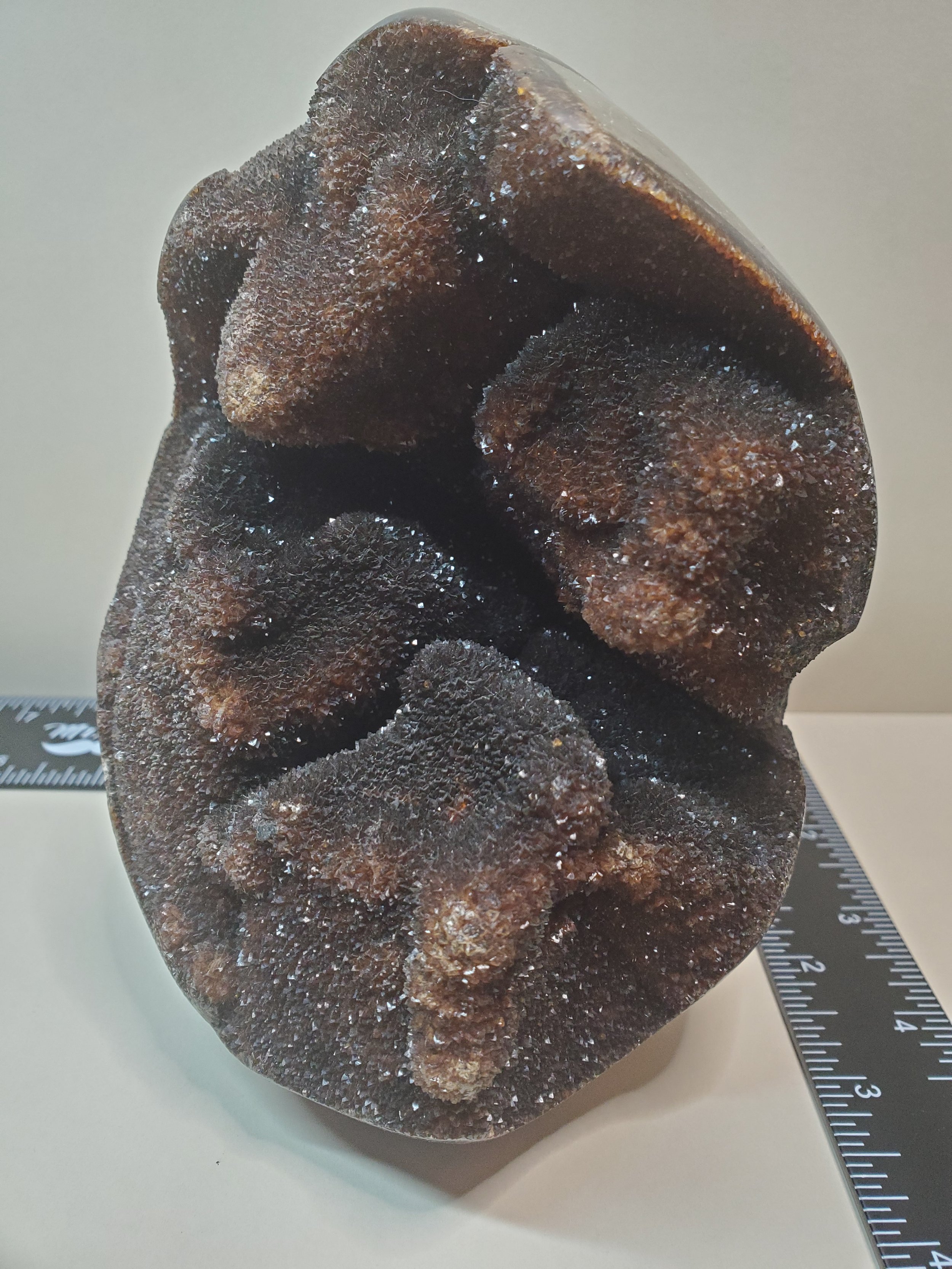Septerian Egg With Druzy
DESCRIPTION3 Pounds 2.9 Ounces
1.444 Kilograms
5 1/2” x 4” x 3”
Septarian is a rock that's a mix of organic matter, mineral, and rock. It's known for its unique cracked or partitioned appearance, and is often called "dragon stone" because of its resemblance to dragon skin.
Here are some things to know about septarian:
Formation
Septarian nodules form from trapped mud and organic matter, volcanic activity, pressure, and desiccation. They were created about 60 million years ago when muddy sediment accumulated on the seafloor.
Composition
Septarian is a tri-colored concretion made up of multiple minerals, including calcite, aragonite, and limestone. The calcite gives the stone a yellow color, the aragonite gives it brown, and the limestone gives it gray.
Shapes
Septarian nodules can form in many different shapes, including spheres, pyramids, and others.
Care
To clean septarian, gently rinse it with warm water. Don't use harsh chemicals, ultrasonic devices, or steam cleaners. Keep septarian away from harder materials, and store it in a soft pouch or bead tray.
Uses
Septarian is sometimes used in crystal healing. It's believed to have many healing properties, including helping with seasonal affective disorder (SAD), improving communication, and cleansing the aura.
DESCRIPTION3 Pounds 2.9 Ounces
1.444 Kilograms
5 1/2” x 4” x 3”
Septarian is a rock that's a mix of organic matter, mineral, and rock. It's known for its unique cracked or partitioned appearance, and is often called "dragon stone" because of its resemblance to dragon skin.
Here are some things to know about septarian:
Formation
Septarian nodules form from trapped mud and organic matter, volcanic activity, pressure, and desiccation. They were created about 60 million years ago when muddy sediment accumulated on the seafloor.
Composition
Septarian is a tri-colored concretion made up of multiple minerals, including calcite, aragonite, and limestone. The calcite gives the stone a yellow color, the aragonite gives it brown, and the limestone gives it gray.
Shapes
Septarian nodules can form in many different shapes, including spheres, pyramids, and others.
Care
To clean septarian, gently rinse it with warm water. Don't use harsh chemicals, ultrasonic devices, or steam cleaners. Keep septarian away from harder materials, and store it in a soft pouch or bead tray.
Uses
Septarian is sometimes used in crystal healing. It's believed to have many healing properties, including helping with seasonal affective disorder (SAD), improving communication, and cleansing the aura.
DESCRIPTION3 Pounds 2.9 Ounces
1.444 Kilograms
5 1/2” x 4” x 3”
Septarian is a rock that's a mix of organic matter, mineral, and rock. It's known for its unique cracked or partitioned appearance, and is often called "dragon stone" because of its resemblance to dragon skin.
Here are some things to know about septarian:
Formation
Septarian nodules form from trapped mud and organic matter, volcanic activity, pressure, and desiccation. They were created about 60 million years ago when muddy sediment accumulated on the seafloor.
Composition
Septarian is a tri-colored concretion made up of multiple minerals, including calcite, aragonite, and limestone. The calcite gives the stone a yellow color, the aragonite gives it brown, and the limestone gives it gray.
Shapes
Septarian nodules can form in many different shapes, including spheres, pyramids, and others.
Care
To clean septarian, gently rinse it with warm water. Don't use harsh chemicals, ultrasonic devices, or steam cleaners. Keep septarian away from harder materials, and store it in a soft pouch or bead tray.
Uses
Septarian is sometimes used in crystal healing. It's believed to have many healing properties, including helping with seasonal affective disorder (SAD), improving communication, and cleansing the aura.









